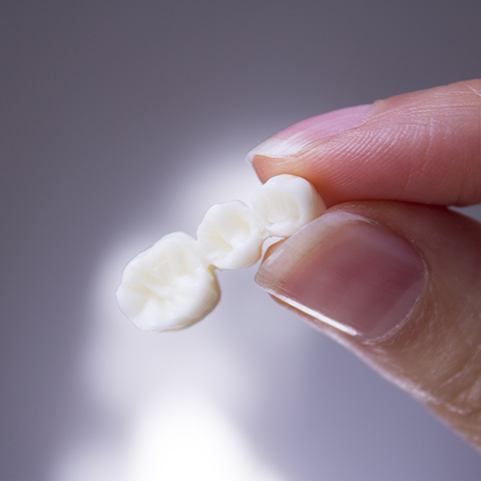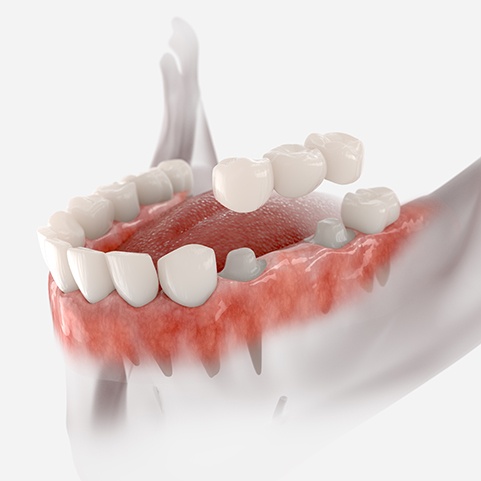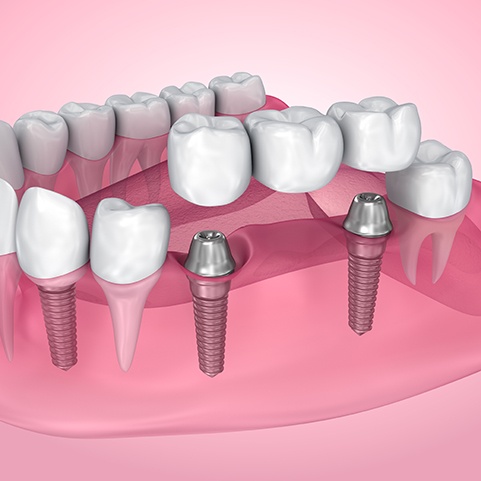Dental Bridges – Lewisville
Fill the Gap in Your Smile
Missing a single tooth is enough to make a huge difference in your quality of life. Having a gap in your smile can make it difficult to complete all sorts of tasks that you once found easy, like chewing your food, speaking clearly, and smiling without feeling self-conscious. At Nexus Dental of Lewisville, we offer dental bridges to fill the gap in your smile! To learn more about dental bridges or to schedule a consultation, give us a call!

Why Choose Nexus Dental of Lewisville for Dental Bridges?
- Customized for Optimal Comfort
- Made from Lifelike Materials
- We Welcome Dental Insurance
What Is a Dental Bridge?

A dental bridge is a restoration that is comprised of two dental crowns and a number of replacement teeth between them called “pontics.” This restoration works by “bridging” the gap in your smile. The two dental crowns are placed on the teeth or dental implants on each side of the gap. Connecting them are the pontics that seamlessly fill in the space.
Types of Dental Bridges
There are two different types of dental bridges that cater to different needs. Here’s what each one consists of.
Traditional Dental Bridge

If you have healthy teeth on either side of the gap that needs to be filled in, a traditional dental bridge is often the ideal solution. The teeth that support the dental crown are called “abutment teeth,” and they are altered slightly so the bridge fits comfortably in the mouth. This type of restoration can be placed in just two visits to the dental office and is the more affordable option out of the two.
Implant Bridge

If you don’t have healthy adjacent teeth, surgically implanted metal posts, also called dental implants, make an excellent alternative. Dental implants can be used when there are three or more missing teeth in a row. Implant bridges tend to last longer than traditional bridges on average, and they help to prevent bone loss over time.
The Benefits of Getting a Dental Bridge

Here are some of the benefits that you can experience when you opt for a dental bridge:
- Prevents surrounding teeth from shifting around
- Improves overall confidence and self-esteem
- Allows for thorough chewing
- Improves speech articulation
- Lowers risk of oral health issues
- Cost-effective tooth replacement option
Dental Bridges FAQs
Can You Take a Dental Bridge Out?
No, a dental bridge is designed to stay in your mouth. We’ll fix it in place quite securely to ensure you’re able to eat and speak without it falling out or slipping. For all intents and purposes, a dental bridge is a “permanent” restoration that can only be removed by a qualified dental professional!
If you need help with your dental bridge, please don’t attempt to take it out on your own, as you might damage it or harm your natural teeth. We’ll take care of this process for you and make any necessary adjustments or repairs on your behalf.
What Are Dental Bridges Made Of?
Dental bridges can be made from many different materials and material combinations. Here’s what your dentist in Lewisville offers:
- All-porcelain – As the name suggests, these bridges are 100% porcelain, making them durable and incredibly life-like.
- Porcelain-fused-to-metal – A porcelain outer shell provides stunning aesthetics, while a metal inner core enhances durability and longevity.
- EMAX – Essentially, these are made from a complex glass ceramic material. EMAX bridges are perfect for short restorations, but the strength becomes compromised as the bridge gets longer, so your treatment needs will be an important consideration.
- Zirconia – Like porcelain, zirconia is a type of ceramic with many advantages. It holds up slightly better than porcelain, though, making it a good choice if longevity is your priority.
- Gold – Metals have been used to replace missing teeth for decades. Though the material is more noticeable than tooth-colored alternatives, gold does last a long time and is slow to wear.
Rest assured, this is something we’ll talk about during your consultation. Our team will help make sure you receive the best restoration for you and your smile!
Is a Partial Denture the Same as a Bridge?
Not quite. You might sometimes hear partial dentures referred to as “removable bridges,” but these two restorations are very different.
A bridge is designed specifically to replace one or more missing teeth that are lined up in a row. The two “pontics” on the end will fit over the natural teeth on either side of your gap, sort of like a crown. The false teeth are connected to the pontics and are supported by them.
Partial dentures, unlike traditional bridges, can be removed by patients with ease. They can replace multiple missing teeth in any configuration. Instead of being supported by pontics, the false pearly whites in a partial denture are attached to a metal base.
Both restorations can replace multiple teeth at once, but ultimately, they each satisfy different treatment needs.
How Do I Clean Under My Dental Bridge?
Excellent question! It’s just as important to clean the space underneath your bridge as it is to brush the more visible portions. There are a couple of different methods you can try – all are effective at mitigating the bacteria content in your mouth, so choose the one that works best for you:
- Traditional threaded floss. You can simply use floss by sliding it underneath your bridge and out the other side. Floss threaders can help you maneuver the floss and control it more easily.
- Interdental brush – a.k.a. the “interproximal brush” and “Christmas tree brush.” This is basically a long wire with a puffy bush of bristle on the end. The wire handle makes it easy to get the bristled brush underneath your bridge.
- Water flosser. These modernized tools spray a gentle yet effective jet of water, enabling you to simply point, click, and blast bacteria and debris out from underneath your bridge. It also works as a great alternative to traditional floss!
